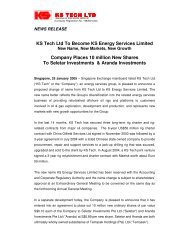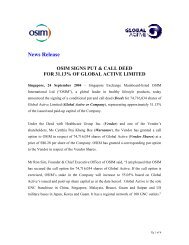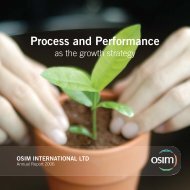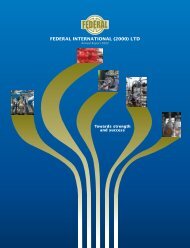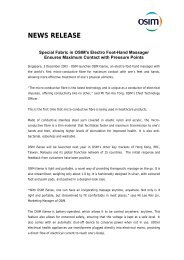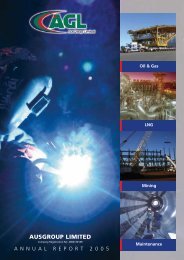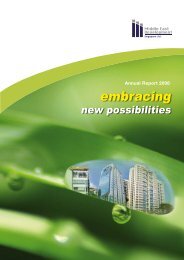ANNUAL REPORT
ANNUAL REPORT
ANNUAL REPORT
Create successful ePaper yourself
Turn your PDF publications into a flip-book with our unique Google optimized e-Paper software.
46Middle East Development Singapore ltdannual report 2007NOTES TO FINANCIALSTATEMENTS30 June 20072. SUMMARY OF SIGNIFICANT ACCOUNTING POLICIES (Cont’d)REVENUE RECOGNITION – The revenue amount is the fair value of the consideration received or receivable from the grossinflow of economic benefits during the year arising from the course of the ordinary activities of the entity and it is shown net ofrelated tax, estimated returns, discounts and volume rebates. Revenue from sale of goods is recognised when significant risksand rewards of ownership are transferred to the buyer, there is neither continuing managerial involvement to the degree usuallyassociated with ownership nor effective control over the goods sold, and the amount of revenue and the costs incurred or to beincurred in respect of the transaction can be measured reliably. Revenue from rendering of services that are of short durationis recognised when the services are completed. Revenue from rendering of long-term services is recognised by reference to thestage of completion of the transaction at the balance sheet date determined by the proportion of the cost incurred to date bearsto the estimated total cost of the transaction and the amount of revenue, stage of completion, and the costs incurred for thetransaction and the costs to complete the transaction can be measured reliably. Rental revenue is recognised on a time-proportionbasis that takes into account the effective yield on the asset. Interest revenue is recognised on a time-proportion basis that takesinto account the effective yield on the asset. Dividend revenue from investments is recognised when the shareholders’ right toreceive the dividend is legally established.FOREIGN CURRENCY TRANSACTIONS – The functional currency is the Singapore dollar as it reflects the primary economicenvironment in which the entity operates. Transactions in foreign currencies are recorded in the functional currency at therates ruling at the dates of the transactions. At each balance sheet date, recorded monetary balances and balances measuredat fair value that are denominated in foreign currencies are reported at the rates ruling at the balance sheet and fair value datesrespectively. All realised and unrealised exchange adjustment gains and losses are dealt with in the income statement. Thepresentation is in the functional currency.FOREIGN CURRENCY FINANCIAL STATEMENTS – The foreign entities determine the appropriate functional currency as itreflects the primary economic environment in which the entities operate. In translating the financial statements of a foreignentity for incorporation in the combined financial statements the assets and liabilities denominated in currencies other than thefunctional currency of the group are translated at year end rates of exchange and the income and expense items are translated ataverage rates of exchange for the year. The resulting translation adjustments (if any) are accumulated in a separate componentof equity until the disposal of the foreign entity.BORROWING COSTS – All borrowing costs that are interest and other costs incurred in connection with the borrowing of fundsare recognised as an expense in the period in which they are incurred except for borrowing costs that are directly attributable tothe acquisition, construction or production of a qualifying asset that necessarily take a substantial period of time to get ready fortheir intended use or sale are capitalised as part of the cost of that asset until substantially all the activities necessary to preparethe qualifying asset for its intended use or sale are complete. The interest expense is calculated using the effective interest ratemethod.INCOME TAX – The income taxes are accounted using the asset and liability method that requires the recognition of taxespayable or refundable for the current year and deferred tax liabilities and assets for the future tax consequence of events thathave been recognised in the financial statements or tax returns. The measurements of current and deferred tax liabilities andassets are based on provisions of the enacted or substantially enacted tax laws; the effects of future changes in tax laws or ratesare not anticipated. Income tax expense represents the sum of the tax currently payable and deferred tax. Deferred tax assetsand liabilities are offset when they relate to income taxes levied by the same income tax authority. The carrying amount ofdeferred tax assets is reviewed at each balance sheet date and is reduced, if necessary, by the amount of any tax benefits that,based on available evidence, are not expected to be realised. A deferred tax amount is recognised for all temporary differences,unless the deferred tax amount arises from (a) goodwill for which amortisation is not deductible for tax purposes; or (b) the initialrecognition of an asset or liability in a transaction which (i) is not a business combination; and (ii) at the time of the transaction,affects neither accounting profit nor taxable profit (tax loss). A deferred tax liability is not recognised for all taxable temporarydifferences associated with investments in subsidiaries and associates because (a) the company is able to control the timing of thereversal of the temporary difference; and (b) it is probable that the temporary difference will not reverse in the foreseeable future.




